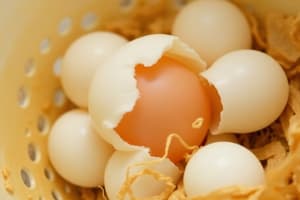Podcast
Questions and Answers
What are the three main stages of oocyte development?
What are the three main stages of oocyte development?
- Primordial follicle development, 2. Primary oocyte growth and maturation, 3. Secondary oocyte maturation and ovulation
Describe the primary oocyte growth and maturation stage.
Describe the primary oocyte growth and maturation stage.
The oocyte grows and matures but does not complete meiosis I until stimulated during a suitable time for ovulation.
What happens during secondary oocyte maturation and ovulation?
What happens during secondary oocyte maturation and ovulation?
The primary oocyte enters meiosis I, divides into a secondary oocyte and a polar body, which may undergo further division.
Why is the dictyate stage significant in oocyte development?
Why is the dictyate stage significant in oocyte development?
What is the outcome of a secondary oocyte that is not fertilized?
What is the outcome of a secondary oocyte that is not fertilized?
What hormone stimulates the growth and development of ovarian follicles containing oocytes?
What hormone stimulates the growth and development of ovarian follicles containing oocytes?
Which hormone triggers the maturation process and ovulation in oocyte maturation?
Which hormone triggers the maturation process and ovulation in oocyte maturation?
What is the role of gonadotropin-releasing hormone (GnRH) in oocyte maturation?
What is the role of gonadotropin-releasing hormone (GnRH) in oocyte maturation?
How does age influence oogenesis?
How does age influence oogenesis?
What are some environmental factors that can impact oogenesis?
What are some environmental factors that can impact oogenesis?
Flashcards are hidden until you start studying
Study Notes
Oogenesis: The Journey of Egg Cells
Oogenesis, a process unique to female organisms, is the development of female gametes—egg cells or oocytes. This elaborate process involves a sequence of events that transform a diploid primordial germ cell into a mature, haploid egg that can fuse with a sperm cell (spermatogenesis takes place in males).
Oocyte Development
The oocyte development process begins during embryonic stages and progresses through three main stages:
- Primordial follicle development: A diploid primordial germ cell differentiates into an oogonium, which enlarges and forms a primitive oocyte surrounded by a single layer of supporting cells (granulosa cells).
- Primary oocyte growth and maturation: The oocyte grows and matures, but it does not complete meiosis I until it is stimulated during a suitable time for ovulation. This stage, known as the dictyate (or diplotene stage), can last for a long time, making the primary oocyte a distinctive feature of female fertility.
- Secondary oocyte maturation and ovulation: The primary oocyte enters meiosis I, and if fertilization does not occur, it finishes meiosis (divides into two haploid cells: a larger secondary oocyte and a smaller polar body). The secondary oocyte may be fertilized, leading to a zygote, or the polar body may undergo its own division to form a second polar body.
Oocyte Maturation
The maturation stage of oocyte development is a critical period that prepares the egg for fertilization. Oocyte maturation is regulated by various hormones and external factors and takes place in a specialized structure called the ovary.
- Gonadotropin-releasing hormone (GnRH): The hypothalamus secretes GnRH, stimulating the anterior pituitary gland to produce luteinizing hormone (LH) and follicle-stimulating hormone (FSH).
- FSH and LH: FSH stimulates the growth and development of ovarian follicles (containing oocytes), and LH triggers the maturation process and ovulation.
- Follicle-stimulating hormone (FSH): FSH activates the expression of genes that support the growth and maturation of the oocyte.
- Luteinizing hormone (LH): LH stimulates the oocyte to complete meiosis I (ovulation) and mature into a secondary oocyte.
Factors Influencing Oogenesis
Several factors influence oogenesis, including the following:
- Genetic factors: Oogenesis is regulated by various genes that control the development and maturation of oocytes.
- Hormonal factors: Ovulation and maturation are regulated by hormones such as FSH, LH, estrogen, and progesterone.
- Age: Oogenesis is influenced by a woman's age, as the number of oocytes decreases with time, and the quality of oocytes may deteriorate.
- Environmental factors: Factors such as pollution, radiation, and lifestyle choices can impact oogenesis.
- Genetic disorders: Oogenesis can be affected by genetic disorders such as Turner syndrome, which results in the absence or partial absence of one of the two X chromosomes.
In summary, oogenesis is a complex and essential process that ensures the formation of healthy, mature egg cells. The process involves three stages of oocyte development, including secondary oocyte maturation. Oogenesis is regulated by various hormones, genetic factors, and environmental factors, and it is crucial for fertilization and the continuation of life.
Studying That Suits You
Use AI to generate personalized quizzes and flashcards to suit your learning preferences.




